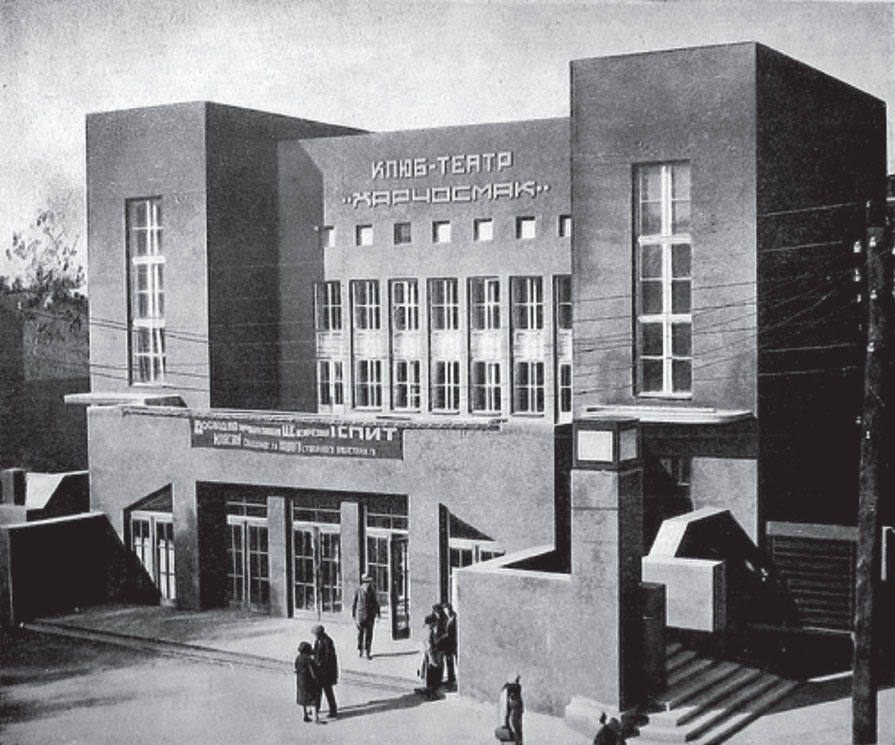Workers’ Clubs
Downloads
DOI:
https://doi.org/10.52200/docomomo.70.06Keywords:
Ukrainian modernism, public buildings, avant-garde architecture, Kharkiv workers’ clubsAbstract
Among the avant-garde monuments preserved in Kharkiv and creating its unique architectural character, the buildings of workers’ clubs occupy a special place. The construction of buildings with such a function began in Kharkiv at the beginning of the 20th century, but after the October Revolution, workers’ clubs became almost the main symbol of the era, because they symbolized the desire for a new life and the creation of a new person. In the works of avant-garde architects, the club became a favorite design theme. During the architectural competitions of the early and mid-1920s, a typology of club buildings was compiled and original compositional and artistic solutions formed, which reflected a creative discussion about the development of Ukrainian architecture: the struggle against the revival of baroque trends ended with the victory of a new direction — Modernism. The architecture of Kharkiv workers’clubs in the 1920s and 1930s reflects the development trends of Ukrainian modernism, but it has its own characteristics related to both regional features and the individuality of the masters who took part in their design. Kharkiv’s clubs reflect the diversity of views of, and approaches to, form-giving by architects with different views and experience, whose buildings constitute a unique architectural heritage. The purpose of this study is to identify the characteristic features of Kharkiv workers’ clubs and determine their place in the general picture of Ukrainian modern architecture for the further development of a program for their preservation. The research uses the methods of historical-architectural, functional-structural and stylistic analysis, which includes traditional general scientific approaches. The material collected, analyzed and systematized in this article can be used for further scientific research in the field of the development of historic architecture, for the implementation of project proposals for the restoration and conservation of individual monuments, and in education.
How to Cite
Published
Issue
Section
License
Copyright (c) 2024 Olha Deriabina, Marina Pominchuk, Olena Konoplova

This work is licensed under a Creative Commons Attribution 4.0 International License.
Plaudit
References
ALEKSANDROV, P. A. (1971). Ivan Leonidov. Izdatelstvo literatury po stroitelstvu.
ASTAFIEVA-DLUGACH, M.I., & VOLCHOK, Y.P. (1989). About the competition for the Palace of Soviets. Zodchestvo–3 (22), 222–238.
BOURYAK A. P., & KREIZER I. I. (2000). Between Constructivism and Art Deco. Method and style in the architecture of Kharkiv in the 20s and 30s. A.S.S. No. 3, 100–103.
BOURYAK, А., DIDENKO, C., & DERIABINA, O. (2009). Clubs for People in Kharkov, Ukraine. ARCHITECTURE DE LA CULTURE. RELAIS DU POUVOIR EUROPEEN, Siècle/2, 54–58.
CHERKASOVA E. T. Architectural heritage of Kharkiv of the era of the Soviet avant-garde as a historical area. Traditions and innovations in higher architectural and artistic education [under general editorship N. E. Tregub]. A special issue based on the materials of the International Scientific and Practical Conference “Constructivism in Ukraine” dedicated to the celebration of the 75th anniversary of Derzhprom. KhDADM, No. 6/2005.
COHEN, J.-L., LODDER, C., PARE, R., & AMETOV, M. (2011). Building the Revolution: Soviet Art and Architecture 1915–1935. London: Royal Academy Books
DERIABINA, O., & POMINCHUK, M. (2020). Forms of design activity organization in 1917–1930s in the USSR. Bulletin of Prydniprovs’ka State Academy of Civil Engineering and Architecture, 1 (261–262), 38–43. DOI: 10.30838/J.BPSACEA.2312.260220.38.608 DOI: https://doi.org/10.30838/J.BPSACEA.2312.260220.38.608
DERYABINA O. A. (2013). Avant-garde Concept of shaping in Architecture of buildings of clubs in Kharkov in the 1920-s – 1930-s [PhD dissertation, Kharkiv National University of Civil Engineering and Architecture].
GAN, A. (1922). Constructivism. Tver’.
GINZBURG, M. YA. (1924). Style and epoch. Publishing house Academy of Sciences of the USSR.
GOLOSOV, I. A. (1933). About the big architectural form. Architecture of the USSR, No. 5.
KHAN-MAGOMEDOV, S. O. (1966). Clubs today and yesterday. Decorative Art of the USSR, No. 9.
KHAN-MAGOMEDOV, S. O. (1967). Leonidov’s clubs. Decorative Art of the USSR. No. 11.
KHAN-MAHOMEDOV, S. O. (2001). The architecture of the Soviet avant-garde. Vol. 2. Social problems. Stroyyzdat.
KHAZANOVA, V.E. (2000) Club life and club architecture (1917–1941). Giraffe
KONOPLYOVA, O., & DERIABINA, O. (2019). Cultural and historical context of genesis and formation of Modernism architecture. Znanstvena misel journal, 34, vol. 1, 11–14
KONOPLYOVA, O., & DERIABINA, O. (2020, February 5–7). Constructivism as a direction in architecture at the beginning of the XX century [Conference session]. Scientific Achievements of Modern Society, Liverpool, United Kingdom. https://sci-conf.com.ua/wp-content/uploads/2020/02/scientific-achievements-of-modern-society-5-7.02.20.pdf
LADOVSKIY, N. A. (1926). Basic principles of building theory of architecture. ASNOVA
LAHUTIN, K. K. (1953). Architectural image of Soviet public buildings: Clubs and Theaters. Mystetstvo.
LAVRENTIEV, A. N. (2010). Alexey Gan. Fund Russian Avant-Garde.
LEONIDOV, I. (1930). Palace of Culture: Towards a discussion about palaces of culture. Modern architecture. No. 5, 1–5
MYLASHEVSKAYA, E.K. (1970). Clubs. Stroyizdat.
RYABUSHIN, A. V., & SHISHKINA, I. V. (1984). Soviet architecture. Stroyizdat
RYCHKOV, P. (2008). Kharkov as a capital of Soviet-Ukrainian modernism. TEKA komisji architektury, Urbanistyki i studiow krajobrazowych. Lublin: Polska Akademia Nauk, Oddzial w Lublinie. https://www.pan-ol.lublin.pl/wydawnictwa/TArch4a/Rychkov.pdf
SBITNEVA, N. F. (2003). Characteristics of the Evolution of Soviet Packaging in the 1930s. Utilitarian and Artistic Aspects [PhD dissertation, Kharkiv State Academy of Design and Arts]
TURCHINSKA, E. YU. (2011). Avant-Garde in the Far East: «Green Cat», Burliuk and others. Aleteyya
YASIEVICH, V. E. (1988). Architecture of Ukraine at the turn of the 19th–20th centuries. Budivelnik





